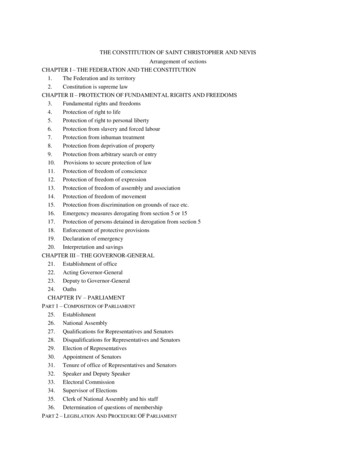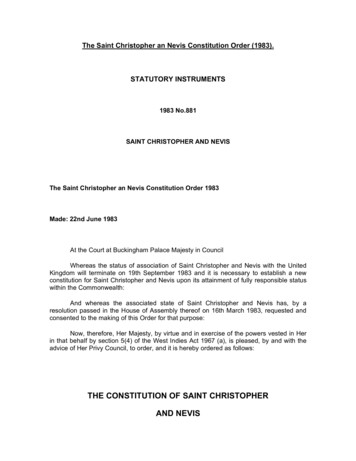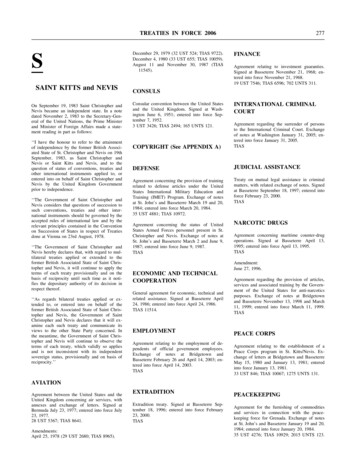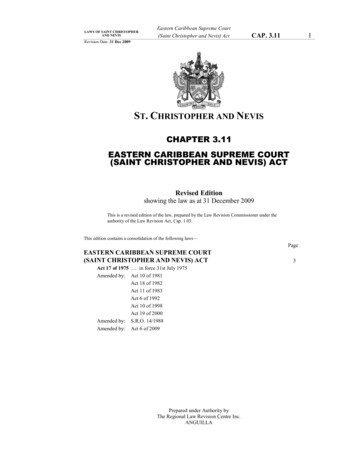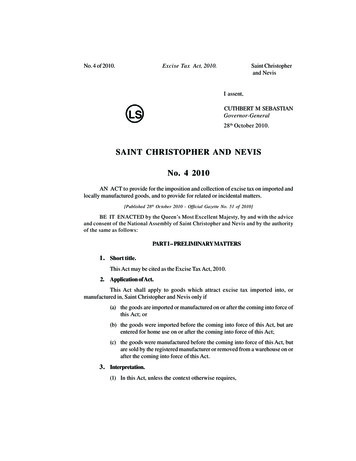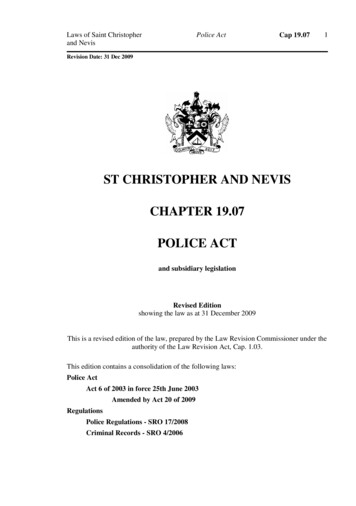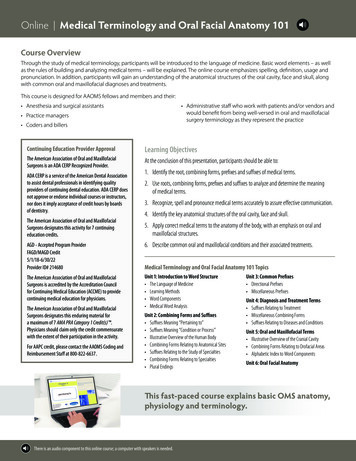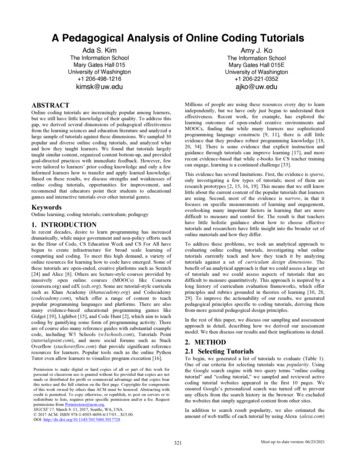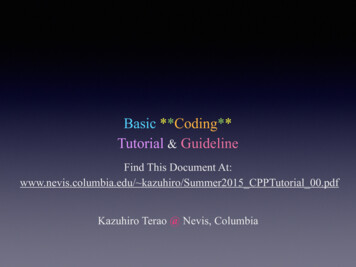
Transcription
Basic **Coding**Tutorial & GuidelineFind This Document At:www.nevis.columbia.edu/ kazuhiro/Summer2015 CPPTutorial 00.pdfKazuhiro Terao @ Nevis, Columbia
Introduction to Programming&Overview of What We Learn
What is “Programming?” Also called “coding” It is to provide a set of instructions for your computer to perform Three steps to achieve in programming‣ “Write”, “Compile”, and “Execute” your programHow to “Write” a Program Write in a “programming language”‣ C/C is one of the most popular & basic language Save it in a text file‣ Pick a text file editor of your choice: emacs, vim, nano, etc. etc.‣ This matters to your coding efficiency! Learn your editor VERY WELL!
How to “Compile” a Program What does it mean to “compile”?‣ What you wrote is a text file‣ Computer doesn’t speak English (it is made by aliens)‣ Compile convert your text file (English) into a computer’s language (byte) Use a “Compiler” to compile your program‣ Made by those awesome dudes who speak alien’s language‣ It translates various programming language into byte code.‣ C compiler: “g ” and “clang ” as most typical choice What is a “compiler” output? roughly 2 types‣ “Executable” a program that “runs” or “execute tasks”‣ “Library” a byte-code description of toolkits, like “functions”
Last Topic: Compiled vs. Interpreted Language Compilation comes with pro and cons- Pros:‣ Compiler checks your program and finds mistakes for you‣ Compiled byte-code gets executed very fast Cons:‣ You have to learn about a compiler apart from the language‣ Everything requires a compilation: not easy to try a simple task Interpreted language- does not require an explicit compilation step- Your program is “compiled” line-by-line when you execute them- Pros‣ You don’t have to compile! (i.e. compilation is a part of execution)‣ Very easy to try a simple thing quickly- Cons‣ No grammar check: you will find a problem in your code @ run-time‣ Line-by-line compilation ends up slow execution speed
So What Are We Going to Cover?You tell me what you want to cover! Basics of C - “Hello World” program learn how to compile a simple program- C class & functions- C class inheritance & templates Basics of Python- “Hello World” program- Python class & functions- “Everything-is-object” Advanced topics- C std libraries (STL containers, std algorithms, etc)- Scientific python libraries (sci/numpy, matplotlib, pandas)- “C in Python” (accessing C class/functions from Python)
What I Do NOT Plan To Cover How to use a text editor How to use “terminal” (i.e. shell language) How to use ROOT (this, we can negotiate )- Very well written tutorial here
C Introduction Link: “if programming languages were vehicle”
C introduction Checkout the example from my web spacewww2.lns.mit.edu/ kazuhiro/Summer2015 CPPIntro.tar.gz If you are on uboonegpvm machine: source /grid/fermiapp/products/uboone/setup uboone.sh setup gcc v4 9 2 Find 7 sub-directories under playground/Introduction- simplest simplest “main” program- example 00 . simple “hello world” program- example 01 . “hello world” using a function- example 02 . “hello world” using a class- example 03 . separation of class/function from driver code- example 04 . class inheritance- example 05 . template Recommended C resource . a lot can be found online- cplusplus.com- cppreference.com
C introduction . simplest Compile simplest.ccIf you are on Unix/Linux with LLVM (OSX, Ubuntu 14)Other Unix/Linux (Ubuntu 12, SL6)Execute simplestCompilation methods same for example 0X
C introduction . example 00 Compile example 00.ccIf you are on Unix/Linux with LLVM (OSX, Ubuntu 14)Other Unix/Linux (Ubuntu 12, SL6)Execute example 00.exeCompilation methods same for example 0X
C introduction . example 01 example 01.cc Introduced C function, “HelloWorldFunc” Nope, nothing more than that. Moving on.
C introduction . example 02 example 02.cc Introduced C class, “HelloWorldClass”- Read (a lot) more about classes here
C introduction Why those 3 trivial (and boring) examples?- remind you about a simple C executable- make sure you know about class/functions- write code with class/functions without a dedicated build system Introduction to reusable code structure- “main” function is a driver function to be executed- Other functions/classes can be re-used for various “main” functions- To achieve this, we use a pre-processor command “#include”
C introduction . example 03example 03.h Defined class/functions in “example 03.h”example 03.cc- now various *.cc can call #include example 03.h and share code Nope, nothing more than that. Moving on.
C introduction . example 04 Class inheritance- Children classes inherit various features from parent class. Read here.- Greatly helps re-usable code designBase class: Polygon- defines “width” and “height”- defines a setter function- defines useless “area” functionChild class: Rectangle- overrides “area” functionChild class: Triangle- overrides “area” functionpolygon.h
C introduction . example 04example 04.ccOutput of executing example 04.exe
C introduction . example 05 Class/Function template- You write abstract description without specifying the subject type. Read here.- Greatly helps re-usable code designClass structures same as example 04But this uses a template type “T” instead of “int”polygon.h
C introduction . example 05Template specialized to float type(classes can be re-used for various type)example 05.ccOutput of executing example 05.exe
C introduction Hope those 6 examples taught/remind you.- How to write a simple C code quickly, compile, and test-run it- C class and functions- Inheritance and class/function template for re-usable code design Example code design for finding “hit” from an waveform I need to read an waveform from a data file I want to fill some histograms of “hit” I want to try writing two algorithms- Gaussian shaped waveform hit- Landau shaped waveform hit
C introduction Hope those 6 examples taught/remind you.- How to write a simple C code quickly, compile, and test-run it- C class and functions- Inheritance and class/function template for re-usable code design Example code design for finding “hit” from an waveformI/O ClassRead data fileManager ClassUse I/O class andexecutes algorithmAlgorithm base classDefines analysis histogramsGausHit AlgorithmFind “gaussian hit”LandauHit AlgorithmFind “landau hit” Writing an algorithm requires minimal effort- Focus on “find hit from an waveform”- Nothing else. No “data read”. No “make TH1”.- Algorithm becomes simple and readable Algorithm base class for common features- All algorithms benefit from changes here‣ e.g.) Add a new histogram I/O class decouples data product dependency- Simply replace I/O class for each fmwk- No need to change the rest of the code
OK. let’s take a break here.Any question?Any coffee/donuts left?
Tutorial & Guideline Kazuhiro Terao @ Nevis, Columbia Find This Document At: . (STL containers, std algorithms, etc) - Scientific python libraries (sci/numpy, matplotlib, pandas) - "C in Python" (accessing C class/functions from Python) You tell me what you want to cover!

